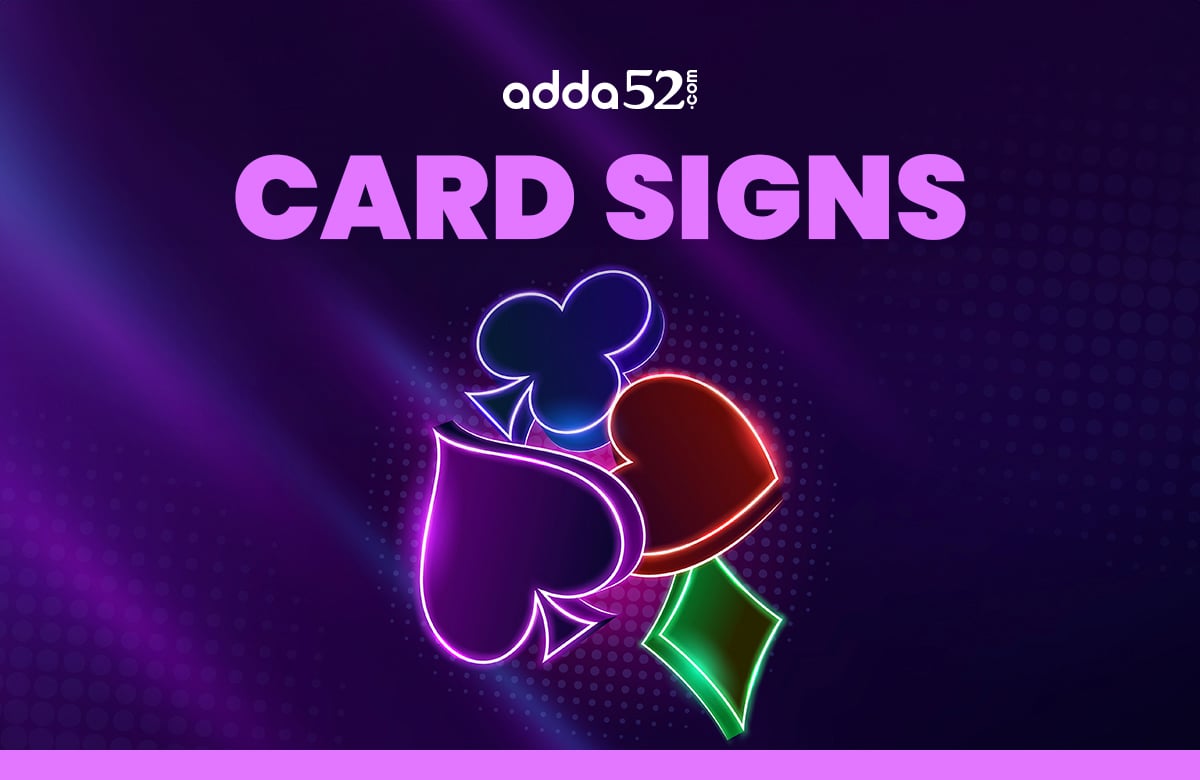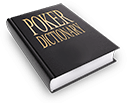Card Signs: More Than Just Symbols

When it comes to playing cards, each symbol is more than just a visual element. It's a rich tapestry of meaning, tradition, and potential. As we talk about card signs, we uncover layers of significance that go beyond their surface representation. Whether you're a casual player or a seasoned enthusiast, understanding the profound meanings behind these symbols adds a new dimension to your experience. In this article, we embark on a journey that unveils the hidden stories and unique roles that each symbol- Heart, Spade, Diamond and Club plays in the captivating realm of card games. Let’s begin!
Spade Card Symbol
The spade, a seemingly simple card symbol, carries layers of history and significance across various card games. Represented as an inverted heart with a pointed apex, the spade symbolises more than just a suit in a deck. Historically, the spade symbol has roots in the leaf from German-suited playing cards, often associated with digging and agriculture. However, in French decks, it transformed into the heraldic pike head, symbolising the spear of the warrior class. This evolution reflects its varied interpretations, representing both the farmer's toil and the warrior's prowess.
In different card games, the spade plays diverse roles. In traditional trick-taking games like bridge and spades, it is a trump suit, holding significant power in determining the course of play. Its prominence extends to the world of poker, where a flush of spades can secure a victory. The spade's influence isn't limited to gameplay; its use in fortune-telling cards adds an esoteric layer, suggesting transformations and challenges.
Interpreting the spade goes beyond the confines of games. It's a symbol intertwined with dichotomies—the labour of the fields juxtaposed with the might of the battlefield. In a broader context, the spade represents the duality of life—a reminder that growth often emerges from the soil of adversity. So, the next time you hold a spade card, whether in strategic gameplay or fortune-telling endeavours, recognize it as more than a symbol. It's a conduit to history, a metaphor for life's journey, and a powerful emblem in the deck of human experiences.
Club Card Symbol
The club symbol, a simple cluster of three shapes resembling a clover or trefoil, carries layers of significance beyond its appearance on playing cards. Describing a club as a stylized clover, its historical roots are intertwined with European mediaeval iconography, representing the symbol of the acorn. This transitioned into the club, signifying a blooming clover or three-leafed plant.
Historically, the club symbol held diverse meanings, ranging from fertility and growth to strength and unity. In the context of card games, it has become an integral part of decks, each suit bearing its own unique identity. In various card games like poker and bridge, the club is a potent suit, often associated with strength, achievement, and force.
Beyond its gaming role, the club card deck has deeper interpretations. Some believe it mirrors the clover's symbolic connection to good luck, while others see it as an emblem of unity and collaboration, given its tripartite structure.
In divination practices, the club can be perceived as a representation of earthly elements, aligning with the tarot suit of Pentacles or Coins, symbolising material wealth and prosperity.
Heart Card Symbol
The heart symbol, a universal icon of love and emotion, transcends its visual simplicity to hold a profound role in the world of playing cards. Representing the essence of affection and passion, the heart symbol is more than just a design on a card; it's a cultural emblem that spans centuries.
The heart symbol, characterised by two rounded lobes meeting at a V-shaped bottom, is a visual representation of the human heart. Its simplicity and symmetry make it instantly recognizable, adding a touch of elegance to the deck of cards.
The heart symbol's historical roots intertwine with cultural and artistic traditions. Emerging in the late mediaeval period, it gained prominence during the Renaissance. Its association with love and emotion solidified its presence in art, literature, and, notably, playing cards.
The heart symbol finds a home in various card games, each attributing its unique significance. In games like poker and rummy, hearts often carry a higher point value, adding strategic depth to gameplay. The Heart suit, in its vibrant red hue, becomes a focal point in games like Bridge and Canasta.
Beyond its role in gaming, the Heart symbol carries interpretations that resonate universally. It symbolises love, compassion, and connection, making it a potent emblem in various cultural and emotional contexts. Whether expressing affection in a handwritten note or signifying a romantic gesture, the Heart symbol speaks its own language.
The Ace of Hearts, often considered the most powerful card in the deck, amplifies the heart symbol's significance. In divination and fortune-telling, the Ace of Hearts symbolism is very strong. It represents love, emotional fulfilment, and positive relationships. Its presence in a card spread is seen as an auspicious sign.
Diamond Card Symbol
The diamond card symbol, characterised by its distinct rhombus shape, stands as a beacon among the array of playing card symbols. Its polished facets and symmetrical allure make it a captivating emblem in the world of cards.
The roots of the diamond symbol trace back centuries, embedded in the cultural tapestry of playing cards. Its historical journey intertwines with the evolution of card games, from their origin in Asia to their flourishing popularity in Europe during the Middle Ages.
The diamond symbol isn't confined to a single card game; instead, it graces the decks of various card games globally. From the elegance of bridge to the strategic depth of poker, the diamond symbol's presence adds a touch of sophistication to the gaming experience.
Beyond its physical form, the diamond symbol carries layers of interpretation and meaning. Often associated with wealth, prosperity, and clarity, the diamond reflects a sense of refinement and precision in the cards it adorns.
Among the royal hierarchy of playing cards, the King of Diamonds card assumes a distinguished position. Clad in regal attire, this card exudes authority and prosperity, mirroring the attributes traditionally associated with the diamond symbol.
Hierarchy of Card Symbols
It is evident that the symbols adorning the cards are more than mere decorations—they hold a hierarchy that profoundly influences gameplay. Understanding which symbol is highest in cards is pivotal for any enthusiast.
In the hierarchy of card symbols, certain patterns emerge. Each suit carries its unique significance, and determining the highest symbol is integral to various card games. Traditionally, the ranking is as follows:
- Spades: Often considered the highest suit in many games, spades embody the essence of the warrior class
- Hearts: Symbolising the struggle for inner peace, hearts hold a prominent position in card hierarchies
- Diamonds: Representing business and wealth creation, diamonds carve a niche as a formidable suit
- Clubs: Emblematic of strength and achievement, clubs round out the hierarchy with their distinctive symbolism
The hierarchy of card symbols directly influences the ranking of cards in the gameplay. Whether you're playing poker, bridge, or any other card game, the suit hierarchy determines which cards triumph over others. The ace of spades, for instance, often holds the coveted position of the highest-ranking card in many games, embodying the strength and prowess associated with spades.
This hierarchy doesn't just dictate the power dynamics in the game—it adds layers of strategy, intrigue, and anticipation. Knowing the pecking order of symbols allows players to make calculated moves, strategizing based on the inherent power each suit carries.
Decoding the Ace Symbol
The Ace stands as a powerful emblem of initiation and potential. It carries the energy of a fresh start, signalling opportunities, and the promise of success. Its role goes beyond a mere numerical value, embodying the idea of the first step in a journey, the commencement of a new phase.
How the Ace is Represented in Different Suits:
- Hearts: It can represent the inception of a new romantic connection or the renewal of existing bonds
- Diamonds: It symbolises the potential for financial success, prosperity, and the initiation of profitable ventures
- Clubs: It signifies the beginning of a victorious journey, emphasising the strength and triumph associated with this suit
- Spades: It represents the initiation of challenges, the beginning of a battle, and the potential for triumph over adversity
Beyond its symbolic significance, the Ace plays a pivotal role in various card games. Its unique ability to be both the lowest and highest-ranking card adds strategic depth to games like poker and blackjack. In some games, it acts as a trump card, holding the power to trump other cards and alter the course of a game. The Ace, with its dual nature, becomes a catalyst for excitement and unpredictability in the realm of card games.
Frequently Asked Questions
Are there specific meanings associated with playing card symbols?
Absolutely, each symbol has rich historical and cultural significance. The spade symbol, for instance, has roots in both agriculture and warfare, while the heart universally represents love and passion.
What is the highest-ranking suit in a standard deck of cards?
In many games, spades are often considered the highest suit, representing the essence of the warrior class. The hierarchy influences the ranking of cards, affecting gameplay dynamics.
How does the Ace symbol add strategic depth to card games?
The Ace, serving as both the lowest and highest-ranking card, introduces unpredictability and excitement. It can represent fresh starts or act as a trump card, altering the course of a game.
Beyond games, do these symbols have broader cultural meanings?
Absolutely, these symbols extend beyond games. For example, hearts symbolise love universally, and diamonds are often associated with wealth. The cultural and emotional significance adds depth to the symbols.
Conclusion
As we unravel the layers of significance behind each suit, we discover that playing cards are more than just symbols. They are gateways to a realm of meaning and potential. Beyond the confines of games, each card carries a narrative that resonates with the essence of human experience. So, the next time you engage with a deck of cards, appreciate the richness embedded in each symbol, recognizing that you're not just playing a game but unlocking a world of profound meaning and possibility.
